International Marketing Report: Analysis of Nestle's Global Operations
VerifiedAdded on 2020/02/12
|10
|2368
|60
Report
AI Summary
This report analyzes the international marketing strategies of Nestle, a multinational food and beverage company. It begins with an executive summary highlighting key findings and reasons for the attractiveness of the industry and market sector. The report then provides background information on the international factors shaping the competitive environment, including globalization, technological advancements, and the emergence of new markets. It emphasizes the importance of adapting marketing strategies to consumer needs and cultural differences. The report also discusses the competitive forces within the industry, utilizing Porter's Five Forces model to assess the intensity of rivalry and its impact on profitability. Key factors influencing competition, such as new entrants, supplier and buyer power, and substitute products, are examined. The analysis concludes that globalization offers more positive impacts than negative ones, emphasizing the need for companies like Nestle to adapt their marketing strategies to succeed in the global market.
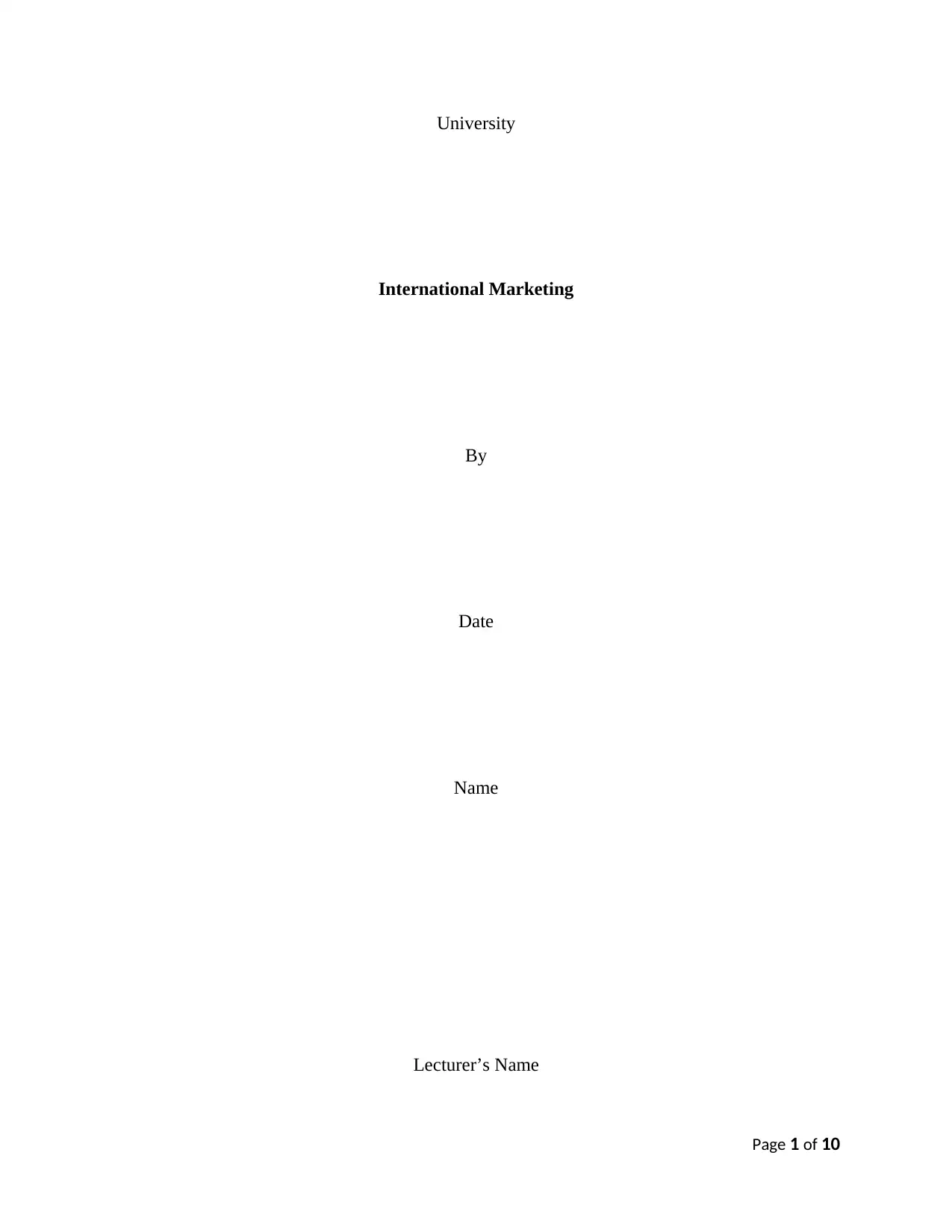
University
International Marketing
By
Date
Name
Lecturer’s Name
Page 1 of 10
International Marketing
By
Date
Name
Lecturer’s Name
Page 1 of 10
Secure Best Marks with AI Grader
Need help grading? Try our AI Grader for instant feedback on your assignments.
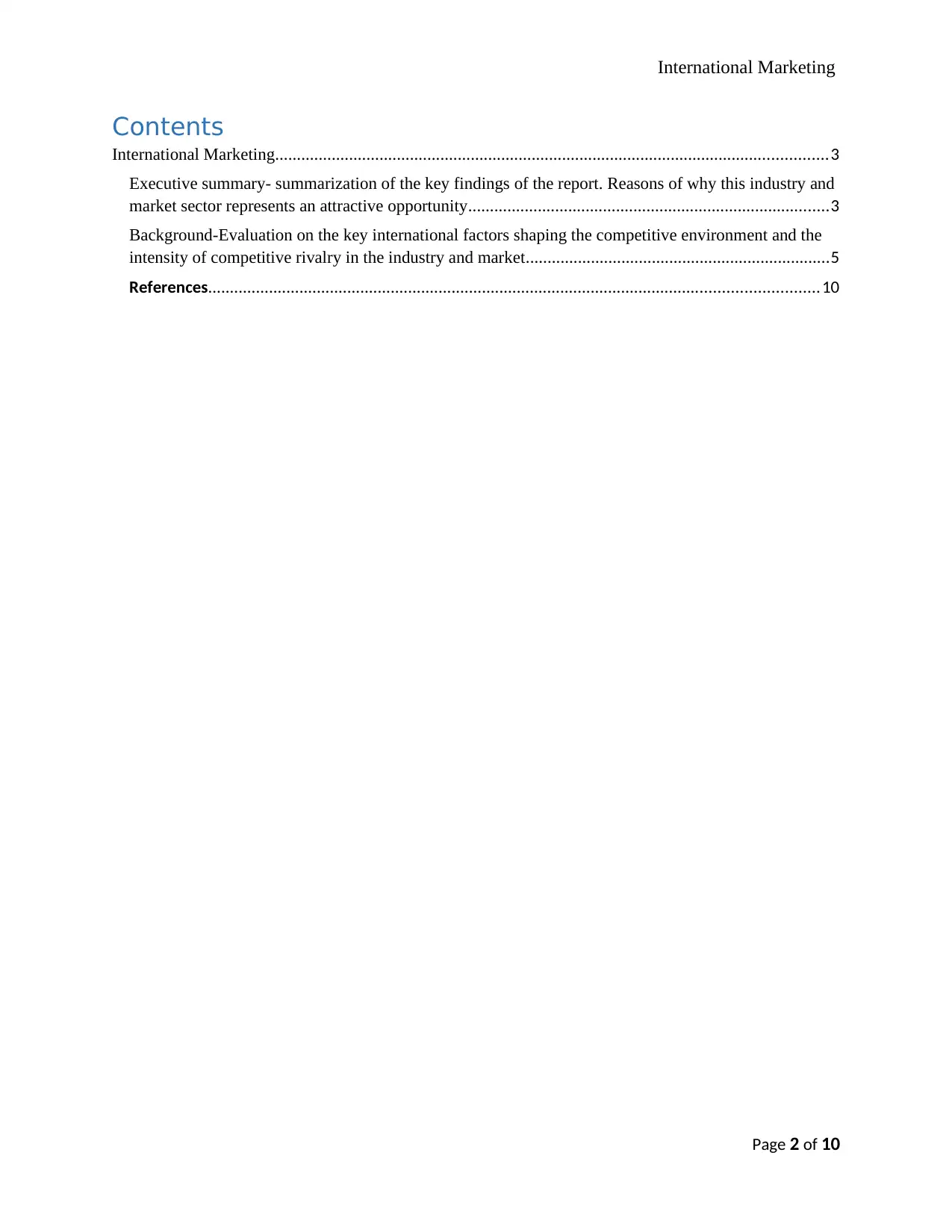
International Marketing
Contents
International Marketing...............................................................................................................................3
Executive summary- summarization of the key findings of the report. Reasons of why this industry and
market sector represents an attractive opportunity...................................................................................3
Background-Evaluation on the key international factors shaping the competitive environment and the
intensity of competitive rivalry in the industry and market......................................................................5
References............................................................................................................................................10
Page 2 of 10
Contents
International Marketing...............................................................................................................................3
Executive summary- summarization of the key findings of the report. Reasons of why this industry and
market sector represents an attractive opportunity...................................................................................3
Background-Evaluation on the key international factors shaping the competitive environment and the
intensity of competitive rivalry in the industry and market......................................................................5
References............................................................................................................................................10
Page 2 of 10
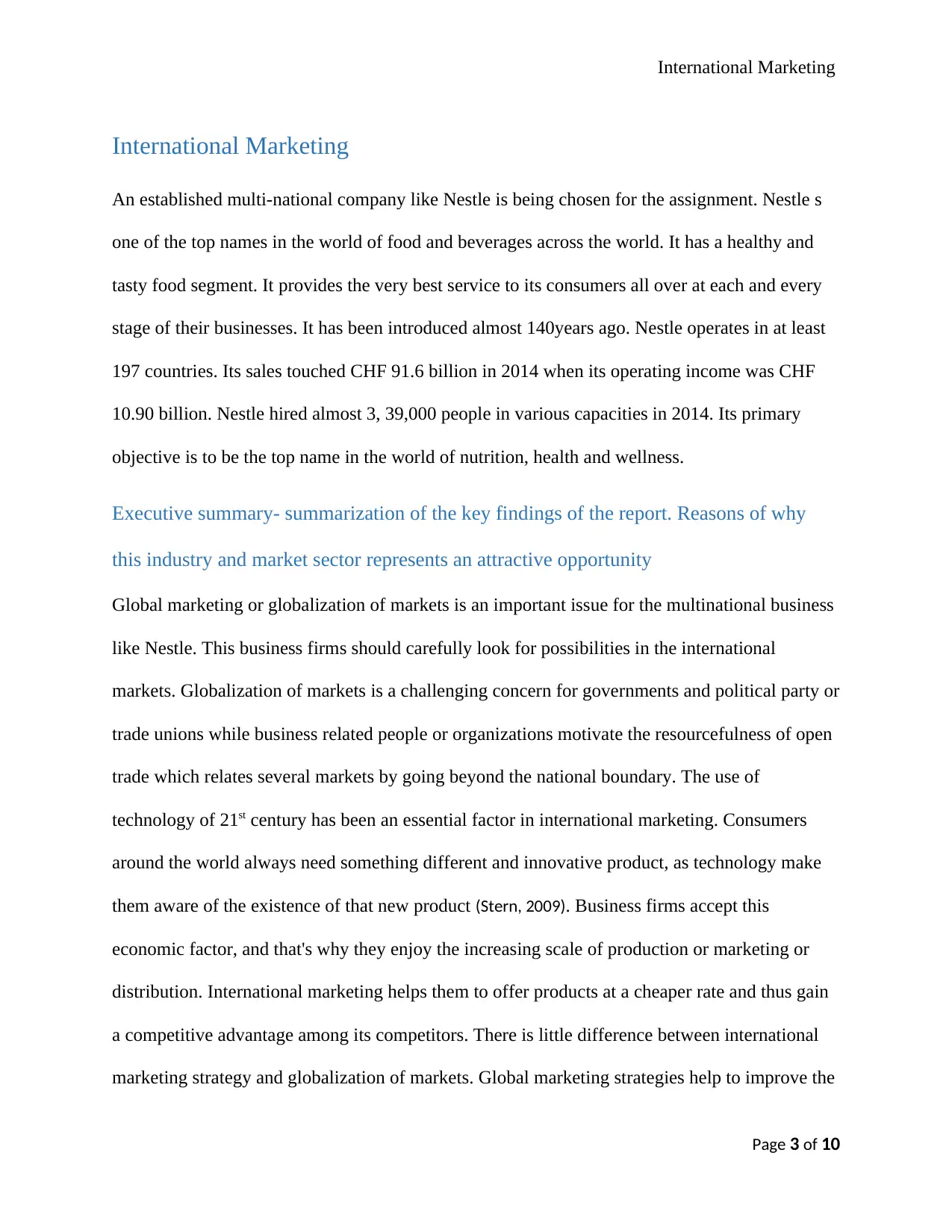
International Marketing
International Marketing
An established multi-national company like Nestle is being chosen for the assignment. Nestle s
one of the top names in the world of food and beverages across the world. It has a healthy and
tasty food segment. It provides the very best service to its consumers all over at each and every
stage of their businesses. It has been introduced almost 140years ago. Nestle operates in at least
197 countries. Its sales touched CHF 91.6 billion in 2014 when its operating income was CHF
10.90 billion. Nestle hired almost 3, 39,000 people in various capacities in 2014. Its primary
objective is to be the top name in the world of nutrition, health and wellness.
Executive summary- summarization of the key findings of the report. Reasons of why
this industry and market sector represents an attractive opportunity
Global marketing or globalization of markets is an important issue for the multinational business
like Nestle. This business firms should carefully look for possibilities in the international
markets. Globalization of markets is a challenging concern for governments and political party or
trade unions while business related people or organizations motivate the resourcefulness of open
trade which relates several markets by going beyond the national boundary. The use of
technology of 21st century has been an essential factor in international marketing. Consumers
around the world always need something different and innovative product, as technology make
them aware of the existence of that new product (Stern, 2009). Business firms accept this
economic factor, and that's why they enjoy the increasing scale of production or marketing or
distribution. International marketing helps them to offer products at a cheaper rate and thus gain
a competitive advantage among its competitors. There is little difference between international
marketing strategy and globalization of markets. Global marketing strategies help to improve the
Page 3 of 10
International Marketing
An established multi-national company like Nestle is being chosen for the assignment. Nestle s
one of the top names in the world of food and beverages across the world. It has a healthy and
tasty food segment. It provides the very best service to its consumers all over at each and every
stage of their businesses. It has been introduced almost 140years ago. Nestle operates in at least
197 countries. Its sales touched CHF 91.6 billion in 2014 when its operating income was CHF
10.90 billion. Nestle hired almost 3, 39,000 people in various capacities in 2014. Its primary
objective is to be the top name in the world of nutrition, health and wellness.
Executive summary- summarization of the key findings of the report. Reasons of why
this industry and market sector represents an attractive opportunity
Global marketing or globalization of markets is an important issue for the multinational business
like Nestle. This business firms should carefully look for possibilities in the international
markets. Globalization of markets is a challenging concern for governments and political party or
trade unions while business related people or organizations motivate the resourcefulness of open
trade which relates several markets by going beyond the national boundary. The use of
technology of 21st century has been an essential factor in international marketing. Consumers
around the world always need something different and innovative product, as technology make
them aware of the existence of that new product (Stern, 2009). Business firms accept this
economic factor, and that's why they enjoy the increasing scale of production or marketing or
distribution. International marketing helps them to offer products at a cheaper rate and thus gain
a competitive advantage among its competitors. There is little difference between international
marketing strategy and globalization of markets. Global marketing strategies help to improve the
Page 3 of 10
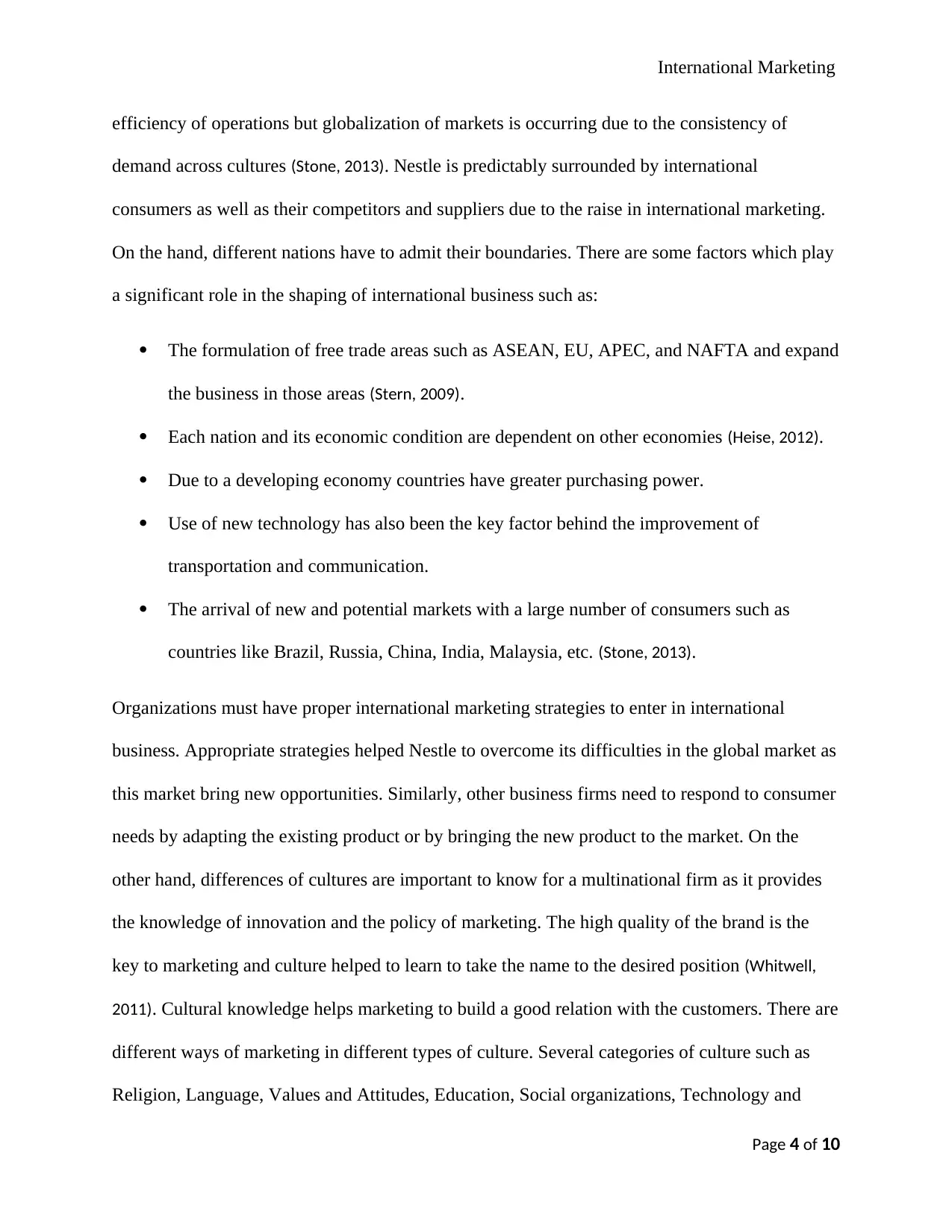
International Marketing
efficiency of operations but globalization of markets is occurring due to the consistency of
demand across cultures (Stone, 2013). Nestle is predictably surrounded by international
consumers as well as their competitors and suppliers due to the raise in international marketing.
On the hand, different nations have to admit their boundaries. There are some factors which play
a significant role in the shaping of international business such as:
The formulation of free trade areas such as ASEAN, EU, APEC, and NAFTA and expand
the business in those areas (Stern, 2009).
Each nation and its economic condition are dependent on other economies (Heise, 2012).
Due to a developing economy countries have greater purchasing power.
Use of new technology has also been the key factor behind the improvement of
transportation and communication.
The arrival of new and potential markets with a large number of consumers such as
countries like Brazil, Russia, China, India, Malaysia, etc. (Stone, 2013).
Organizations must have proper international marketing strategies to enter in international
business. Appropriate strategies helped Nestle to overcome its difficulties in the global market as
this market bring new opportunities. Similarly, other business firms need to respond to consumer
needs by adapting the existing product or by bringing the new product to the market. On the
other hand, differences of cultures are important to know for a multinational firm as it provides
the knowledge of innovation and the policy of marketing. The high quality of the brand is the
key to marketing and culture helped to learn to take the name to the desired position (Whitwell,
2011). Cultural knowledge helps marketing to build a good relation with the customers. There are
different ways of marketing in different types of culture. Several categories of culture such as
Religion, Language, Values and Attitudes, Education, Social organizations, Technology and
Page 4 of 10
efficiency of operations but globalization of markets is occurring due to the consistency of
demand across cultures (Stone, 2013). Nestle is predictably surrounded by international
consumers as well as their competitors and suppliers due to the raise in international marketing.
On the hand, different nations have to admit their boundaries. There are some factors which play
a significant role in the shaping of international business such as:
The formulation of free trade areas such as ASEAN, EU, APEC, and NAFTA and expand
the business in those areas (Stern, 2009).
Each nation and its economic condition are dependent on other economies (Heise, 2012).
Due to a developing economy countries have greater purchasing power.
Use of new technology has also been the key factor behind the improvement of
transportation and communication.
The arrival of new and potential markets with a large number of consumers such as
countries like Brazil, Russia, China, India, Malaysia, etc. (Stone, 2013).
Organizations must have proper international marketing strategies to enter in international
business. Appropriate strategies helped Nestle to overcome its difficulties in the global market as
this market bring new opportunities. Similarly, other business firms need to respond to consumer
needs by adapting the existing product or by bringing the new product to the market. On the
other hand, differences of cultures are important to know for a multinational firm as it provides
the knowledge of innovation and the policy of marketing. The high quality of the brand is the
key to marketing and culture helped to learn to take the name to the desired position (Whitwell,
2011). Cultural knowledge helps marketing to build a good relation with the customers. There are
different ways of marketing in different types of culture. Several categories of culture such as
Religion, Language, Values and Attitudes, Education, Social organizations, Technology and
Page 4 of 10
Secure Best Marks with AI Grader
Need help grading? Try our AI Grader for instant feedback on your assignments.
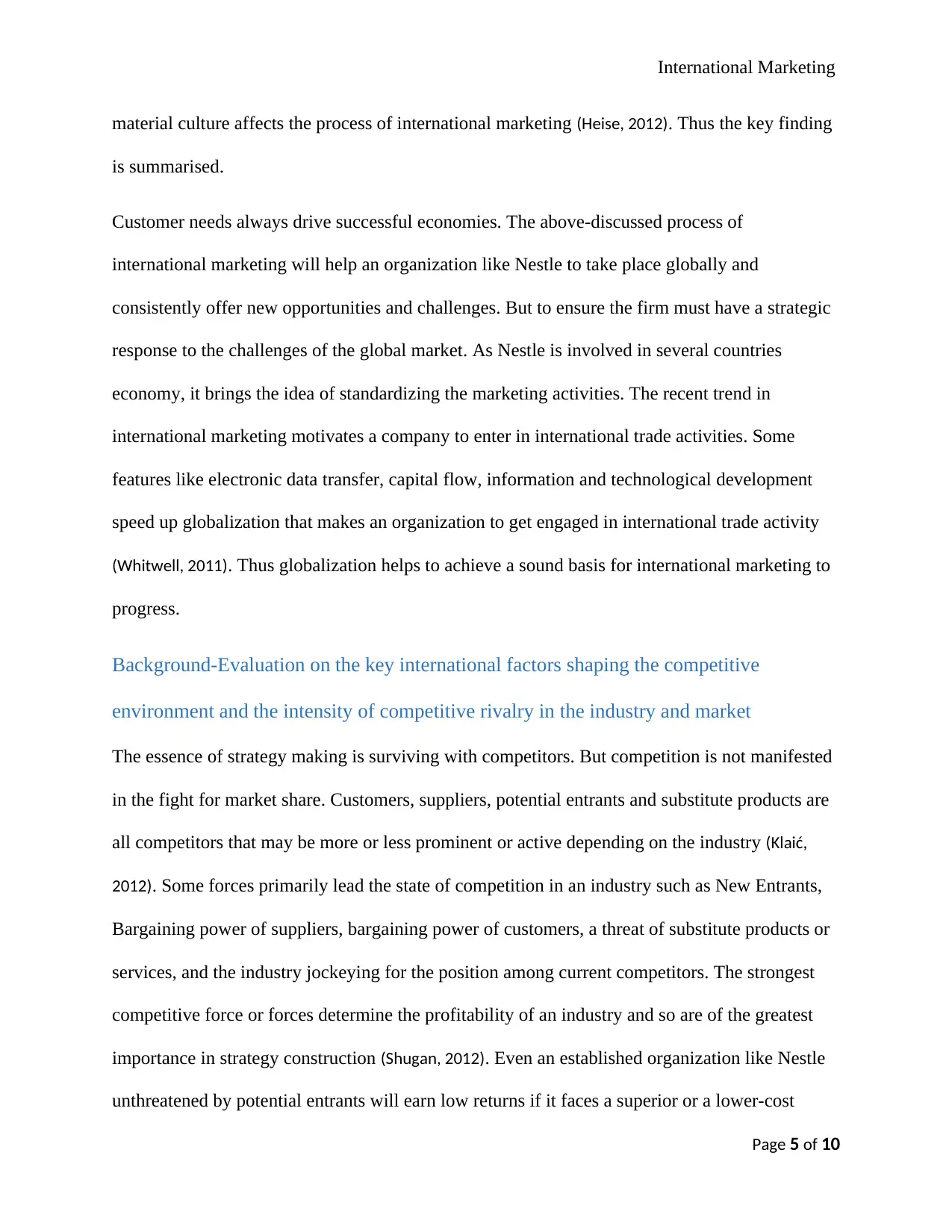
International Marketing
material culture affects the process of international marketing (Heise, 2012). Thus the key finding
is summarised.
Customer needs always drive successful economies. The above-discussed process of
international marketing will help an organization like Nestle to take place globally and
consistently offer new opportunities and challenges. But to ensure the firm must have a strategic
response to the challenges of the global market. As Nestle is involved in several countries
economy, it brings the idea of standardizing the marketing activities. The recent trend in
international marketing motivates a company to enter in international trade activities. Some
features like electronic data transfer, capital flow, information and technological development
speed up globalization that makes an organization to get engaged in international trade activity
(Whitwell, 2011). Thus globalization helps to achieve a sound basis for international marketing to
progress.
Background-Evaluation on the key international factors shaping the competitive
environment and the intensity of competitive rivalry in the industry and market
The essence of strategy making is surviving with competitors. But competition is not manifested
in the fight for market share. Customers, suppliers, potential entrants and substitute products are
all competitors that may be more or less prominent or active depending on the industry (Klaić,
2012). Some forces primarily lead the state of competition in an industry such as New Entrants,
Bargaining power of suppliers, bargaining power of customers, a threat of substitute products or
services, and the industry jockeying for the position among current competitors. The strongest
competitive force or forces determine the profitability of an industry and so are of the greatest
importance in strategy construction (Shugan, 2012). Even an established organization like Nestle
unthreatened by potential entrants will earn low returns if it faces a superior or a lower-cost
Page 5 of 10
material culture affects the process of international marketing (Heise, 2012). Thus the key finding
is summarised.
Customer needs always drive successful economies. The above-discussed process of
international marketing will help an organization like Nestle to take place globally and
consistently offer new opportunities and challenges. But to ensure the firm must have a strategic
response to the challenges of the global market. As Nestle is involved in several countries
economy, it brings the idea of standardizing the marketing activities. The recent trend in
international marketing motivates a company to enter in international trade activities. Some
features like electronic data transfer, capital flow, information and technological development
speed up globalization that makes an organization to get engaged in international trade activity
(Whitwell, 2011). Thus globalization helps to achieve a sound basis for international marketing to
progress.
Background-Evaluation on the key international factors shaping the competitive
environment and the intensity of competitive rivalry in the industry and market
The essence of strategy making is surviving with competitors. But competition is not manifested
in the fight for market share. Customers, suppliers, potential entrants and substitute products are
all competitors that may be more or less prominent or active depending on the industry (Klaić,
2012). Some forces primarily lead the state of competition in an industry such as New Entrants,
Bargaining power of suppliers, bargaining power of customers, a threat of substitute products or
services, and the industry jockeying for the position among current competitors. The strongest
competitive force or forces determine the profitability of an industry and so are of the greatest
importance in strategy construction (Shugan, 2012). Even an established organization like Nestle
unthreatened by potential entrants will earn low returns if it faces a superior or a lower-cost
Page 5 of 10
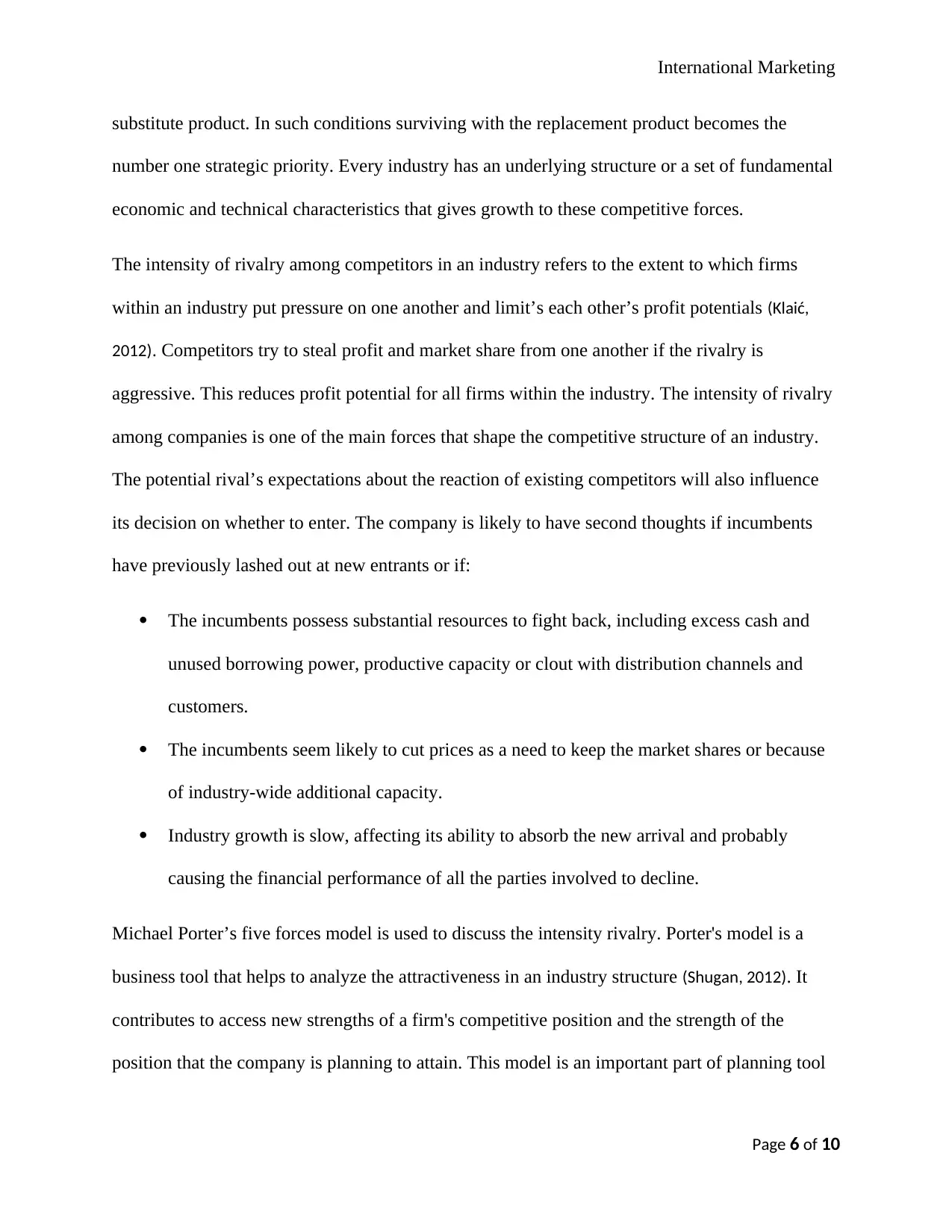
International Marketing
substitute product. In such conditions surviving with the replacement product becomes the
number one strategic priority. Every industry has an underlying structure or a set of fundamental
economic and technical characteristics that gives growth to these competitive forces.
The intensity of rivalry among competitors in an industry refers to the extent to which firms
within an industry put pressure on one another and limit’s each other’s profit potentials (Klaić,
2012). Competitors try to steal profit and market share from one another if the rivalry is
aggressive. This reduces profit potential for all firms within the industry. The intensity of rivalry
among companies is one of the main forces that shape the competitive structure of an industry.
The potential rival’s expectations about the reaction of existing competitors will also influence
its decision on whether to enter. The company is likely to have second thoughts if incumbents
have previously lashed out at new entrants or if:
The incumbents possess substantial resources to fight back, including excess cash and
unused borrowing power, productive capacity or clout with distribution channels and
customers.
The incumbents seem likely to cut prices as a need to keep the market shares or because
of industry-wide additional capacity.
Industry growth is slow, affecting its ability to absorb the new arrival and probably
causing the financial performance of all the parties involved to decline.
Michael Porter’s five forces model is used to discuss the intensity rivalry. Porter's model is a
business tool that helps to analyze the attractiveness in an industry structure (Shugan, 2012). It
contributes to access new strengths of a firm's competitive position and the strength of the
position that the company is planning to attain. This model is an important part of planning tool
Page 6 of 10
substitute product. In such conditions surviving with the replacement product becomes the
number one strategic priority. Every industry has an underlying structure or a set of fundamental
economic and technical characteristics that gives growth to these competitive forces.
The intensity of rivalry among competitors in an industry refers to the extent to which firms
within an industry put pressure on one another and limit’s each other’s profit potentials (Klaić,
2012). Competitors try to steal profit and market share from one another if the rivalry is
aggressive. This reduces profit potential for all firms within the industry. The intensity of rivalry
among companies is one of the main forces that shape the competitive structure of an industry.
The potential rival’s expectations about the reaction of existing competitors will also influence
its decision on whether to enter. The company is likely to have second thoughts if incumbents
have previously lashed out at new entrants or if:
The incumbents possess substantial resources to fight back, including excess cash and
unused borrowing power, productive capacity or clout with distribution channels and
customers.
The incumbents seem likely to cut prices as a need to keep the market shares or because
of industry-wide additional capacity.
Industry growth is slow, affecting its ability to absorb the new arrival and probably
causing the financial performance of all the parties involved to decline.
Michael Porter’s five forces model is used to discuss the intensity rivalry. Porter's model is a
business tool that helps to analyze the attractiveness in an industry structure (Shugan, 2012). It
contributes to access new strengths of a firm's competitive position and the strength of the
position that the company is planning to attain. This model is an important part of planning tool
Page 6 of 10
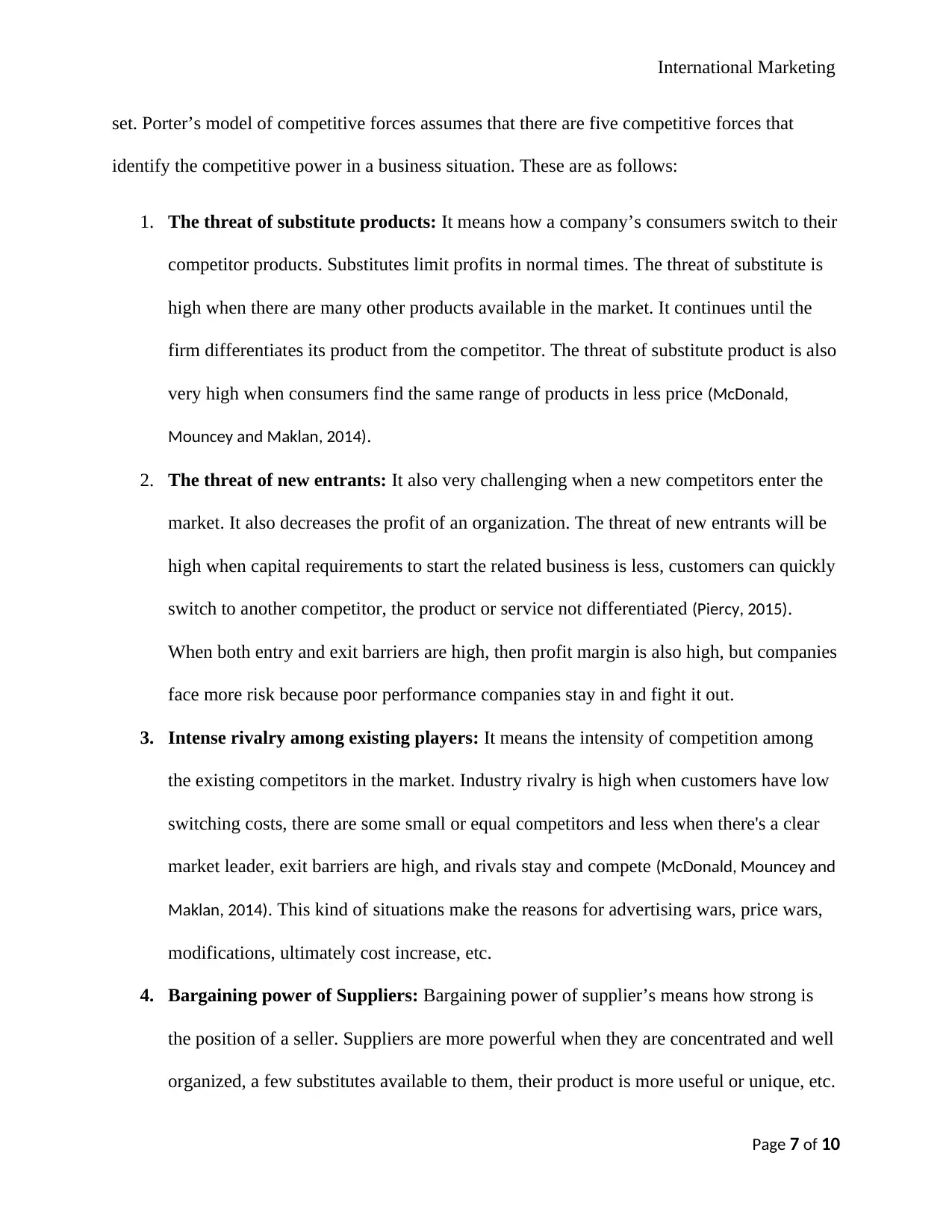
International Marketing
set. Porter’s model of competitive forces assumes that there are five competitive forces that
identify the competitive power in a business situation. These are as follows:
1. The threat of substitute products: It means how a company’s consumers switch to their
competitor products. Substitutes limit profits in normal times. The threat of substitute is
high when there are many other products available in the market. It continues until the
firm differentiates its product from the competitor. The threat of substitute product is also
very high when consumers find the same range of products in less price (McDonald,
Mouncey and Maklan, 2014).
2. The threat of new entrants: It also very challenging when a new competitors enter the
market. It also decreases the profit of an organization. The threat of new entrants will be
high when capital requirements to start the related business is less, customers can quickly
switch to another competitor, the product or service not differentiated (Piercy, 2015).
When both entry and exit barriers are high, then profit margin is also high, but companies
face more risk because poor performance companies stay in and fight it out.
3. Intense rivalry among existing players: It means the intensity of competition among
the existing competitors in the market. Industry rivalry is high when customers have low
switching costs, there are some small or equal competitors and less when there's a clear
market leader, exit barriers are high, and rivals stay and compete (McDonald, Mouncey and
Maklan, 2014). This kind of situations make the reasons for advertising wars, price wars,
modifications, ultimately cost increase, etc.
4. Bargaining power of Suppliers: Bargaining power of supplier’s means how strong is
the position of a seller. Suppliers are more powerful when they are concentrated and well
organized, a few substitutes available to them, their product is more useful or unique, etc.
Page 7 of 10
set. Porter’s model of competitive forces assumes that there are five competitive forces that
identify the competitive power in a business situation. These are as follows:
1. The threat of substitute products: It means how a company’s consumers switch to their
competitor products. Substitutes limit profits in normal times. The threat of substitute is
high when there are many other products available in the market. It continues until the
firm differentiates its product from the competitor. The threat of substitute product is also
very high when consumers find the same range of products in less price (McDonald,
Mouncey and Maklan, 2014).
2. The threat of new entrants: It also very challenging when a new competitors enter the
market. It also decreases the profit of an organization. The threat of new entrants will be
high when capital requirements to start the related business is less, customers can quickly
switch to another competitor, the product or service not differentiated (Piercy, 2015).
When both entry and exit barriers are high, then profit margin is also high, but companies
face more risk because poor performance companies stay in and fight it out.
3. Intense rivalry among existing players: It means the intensity of competition among
the existing competitors in the market. Industry rivalry is high when customers have low
switching costs, there are some small or equal competitors and less when there's a clear
market leader, exit barriers are high, and rivals stay and compete (McDonald, Mouncey and
Maklan, 2014). This kind of situations make the reasons for advertising wars, price wars,
modifications, ultimately cost increase, etc.
4. Bargaining power of Suppliers: Bargaining power of supplier’s means how strong is
the position of a seller. Suppliers are more powerful when they are concentrated and well
organized, a few substitutes available to them, their product is more useful or unique, etc.
Page 7 of 10
Paraphrase This Document
Need a fresh take? Get an instant paraphrase of this document with our AI Paraphraser
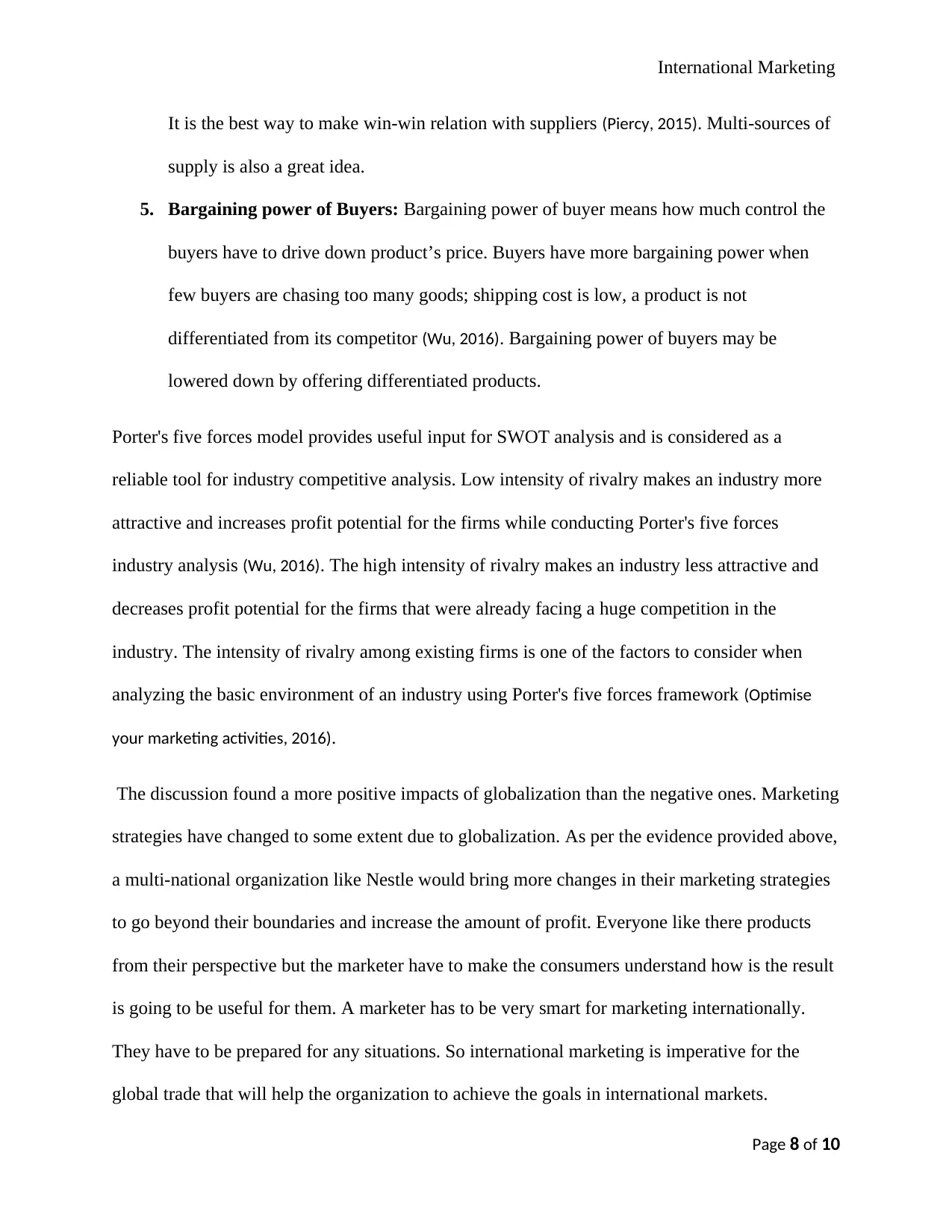
International Marketing
It is the best way to make win-win relation with suppliers (Piercy, 2015). Multi-sources of
supply is also a great idea.
5. Bargaining power of Buyers: Bargaining power of buyer means how much control the
buyers have to drive down product’s price. Buyers have more bargaining power when
few buyers are chasing too many goods; shipping cost is low, a product is not
differentiated from its competitor (Wu, 2016). Bargaining power of buyers may be
lowered down by offering differentiated products.
Porter's five forces model provides useful input for SWOT analysis and is considered as a
reliable tool for industry competitive analysis. Low intensity of rivalry makes an industry more
attractive and increases profit potential for the firms while conducting Porter's five forces
industry analysis (Wu, 2016). The high intensity of rivalry makes an industry less attractive and
decreases profit potential for the firms that were already facing a huge competition in the
industry. The intensity of rivalry among existing firms is one of the factors to consider when
analyzing the basic environment of an industry using Porter's five forces framework (Optimise
your marketing activities, 2016).
The discussion found a more positive impacts of globalization than the negative ones. Marketing
strategies have changed to some extent due to globalization. As per the evidence provided above,
a multi-national organization like Nestle would bring more changes in their marketing strategies
to go beyond their boundaries and increase the amount of profit. Everyone like there products
from their perspective but the marketer have to make the consumers understand how is the result
is going to be useful for them. A marketer has to be very smart for marketing internationally.
They have to be prepared for any situations. So international marketing is imperative for the
global trade that will help the organization to achieve the goals in international markets.
Page 8 of 10
It is the best way to make win-win relation with suppliers (Piercy, 2015). Multi-sources of
supply is also a great idea.
5. Bargaining power of Buyers: Bargaining power of buyer means how much control the
buyers have to drive down product’s price. Buyers have more bargaining power when
few buyers are chasing too many goods; shipping cost is low, a product is not
differentiated from its competitor (Wu, 2016). Bargaining power of buyers may be
lowered down by offering differentiated products.
Porter's five forces model provides useful input for SWOT analysis and is considered as a
reliable tool for industry competitive analysis. Low intensity of rivalry makes an industry more
attractive and increases profit potential for the firms while conducting Porter's five forces
industry analysis (Wu, 2016). The high intensity of rivalry makes an industry less attractive and
decreases profit potential for the firms that were already facing a huge competition in the
industry. The intensity of rivalry among existing firms is one of the factors to consider when
analyzing the basic environment of an industry using Porter's five forces framework (Optimise
your marketing activities, 2016).
The discussion found a more positive impacts of globalization than the negative ones. Marketing
strategies have changed to some extent due to globalization. As per the evidence provided above,
a multi-national organization like Nestle would bring more changes in their marketing strategies
to go beyond their boundaries and increase the amount of profit. Everyone like there products
from their perspective but the marketer have to make the consumers understand how is the result
is going to be useful for them. A marketer has to be very smart for marketing internationally.
They have to be prepared for any situations. So international marketing is imperative for the
global trade that will help the organization to achieve the goals in international markets.
Page 8 of 10
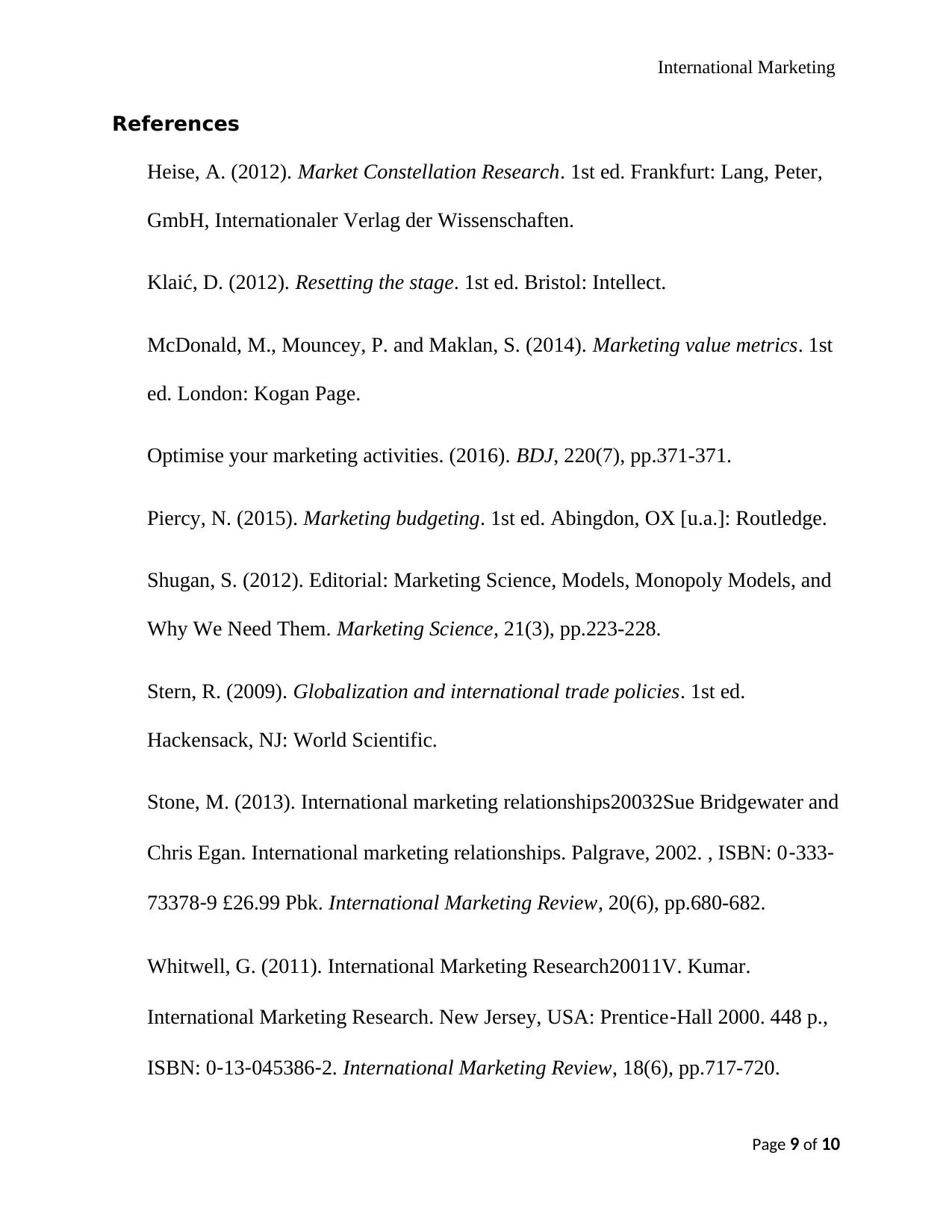
International Marketing
References
Heise, A. (2012). Market Constellation Research. 1st ed. Frankfurt: Lang, Peter,
GmbH, Internationaler Verlag der Wissenschaften.
Klaić, D. (2012). Resetting the stage. 1st ed. Bristol: Intellect.
McDonald, M., Mouncey, P. and Maklan, S. (2014). Marketing value metrics. 1st
ed. London: Kogan Page.
Optimise your marketing activities. (2016). BDJ, 220(7), pp.371-371.
Piercy, N. (2015). Marketing budgeting. 1st ed. Abingdon, OX [u.a.]: Routledge.
Shugan, S. (2012). Editorial: Marketing Science, Models, Monopoly Models, and
Why We Need Them. Marketing Science, 21(3), pp.223-228.
Stern, R. (2009). Globalization and international trade policies. 1st ed.
Hackensack, NJ: World Scientific.
Stone, M. (2013). International marketing relationships20032Sue Bridgewater and
Chris Egan. International marketing relationships. Palgrave, 2002. , ISBN: 0‐333‐
73378‐9 £26.99 Pbk. International Marketing Review, 20(6), pp.680-682.
Whitwell, G. (2011). International Marketing Research20011V. Kumar.
International Marketing Research. New Jersey, USA: Prentice‐Hall 2000. 448 p.,
ISBN: 0‐13‐045386‐2. International Marketing Review, 18(6), pp.717-720.
Page 9 of 10
References
Heise, A. (2012). Market Constellation Research. 1st ed. Frankfurt: Lang, Peter,
GmbH, Internationaler Verlag der Wissenschaften.
Klaić, D. (2012). Resetting the stage. 1st ed. Bristol: Intellect.
McDonald, M., Mouncey, P. and Maklan, S. (2014). Marketing value metrics. 1st
ed. London: Kogan Page.
Optimise your marketing activities. (2016). BDJ, 220(7), pp.371-371.
Piercy, N. (2015). Marketing budgeting. 1st ed. Abingdon, OX [u.a.]: Routledge.
Shugan, S. (2012). Editorial: Marketing Science, Models, Monopoly Models, and
Why We Need Them. Marketing Science, 21(3), pp.223-228.
Stern, R. (2009). Globalization and international trade policies. 1st ed.
Hackensack, NJ: World Scientific.
Stone, M. (2013). International marketing relationships20032Sue Bridgewater and
Chris Egan. International marketing relationships. Palgrave, 2002. , ISBN: 0‐333‐
73378‐9 £26.99 Pbk. International Marketing Review, 20(6), pp.680-682.
Whitwell, G. (2011). International Marketing Research20011V. Kumar.
International Marketing Research. New Jersey, USA: Prentice‐Hall 2000. 448 p.,
ISBN: 0‐13‐045386‐2. International Marketing Review, 18(6), pp.717-720.
Page 9 of 10
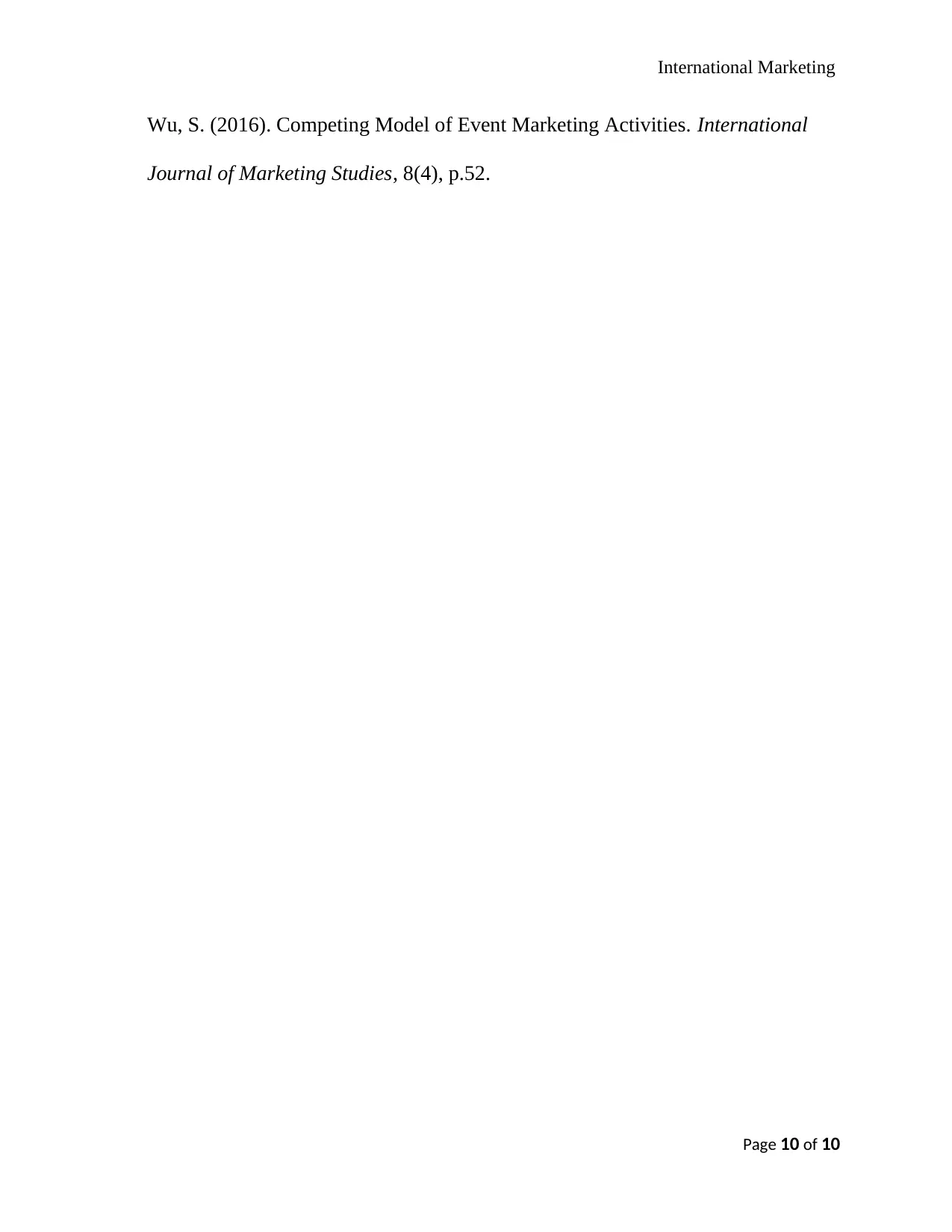
International Marketing
Wu, S. (2016). Competing Model of Event Marketing Activities. International
Journal of Marketing Studies, 8(4), p.52.
Page 10 of 10
Wu, S. (2016). Competing Model of Event Marketing Activities. International
Journal of Marketing Studies, 8(4), p.52.
Page 10 of 10
1 out of 10
Related Documents
Your All-in-One AI-Powered Toolkit for Academic Success.
+13062052269
info@desklib.com
Available 24*7 on WhatsApp / Email
![[object Object]](/_next/static/media/star-bottom.7253800d.svg)
Unlock your academic potential
© 2024 | Zucol Services PVT LTD | All rights reserved.





